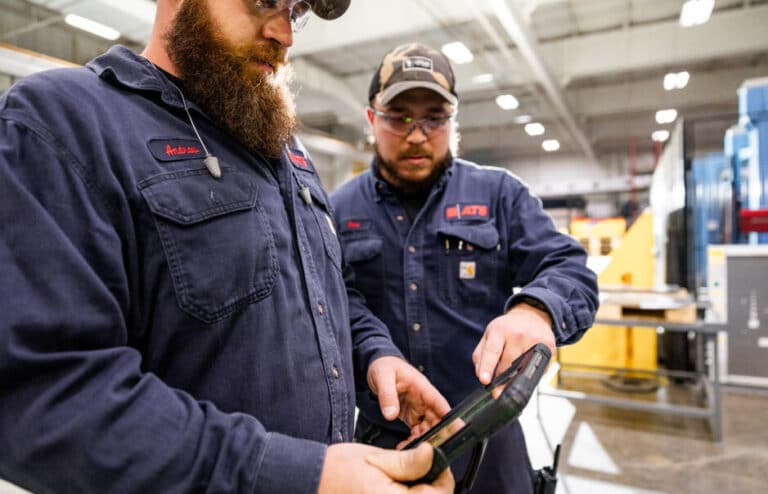Manufacturers need their operations to run as efficiently and consistently as possible. This means they must be as clear as they can with the language they use. For example, many manufacturers may use the terms “process” and “procedure” interchangeably, even though they describe different aspects of operations management.
Understanding the differences of process vs. procedure ensures every member of the team knows exactly what their objectives are and how to achieve them. Read on to learn more about how these two ideas differ and how a computerized maintenance management system (CMMS) can make implementing them in your facility easier.
Difference between process and procedure
Before delving into the specifics, it’s essential to understand the fundamental disparity between processes and procedures. Although both are integral to manufacturing operations, they serve different purposes.
Process: A process is a series of interconnected activities or steps that transform inputs into outputs. It encompasses the overarching framework within which work is performed, focusing on the systematic flow of tasks to achieve a specific goal.
Procedure: On the other hand, a procedure outlines the precise sequence of actions required to carry out a particular task within a process. It provides a detailed roadmap, outlining the necessary steps, responsibilities and operational standards needed to ensure consistency and quality in execution.
What is a process?
A process can be seen as the basic roadmap for an organization to achieve a specific objective. It outlines the entire journey from initiation to completion, encompassing all the tasks, resources and decision points involved. Processes are characterized by their fluidity and adaptability, accommodating changes in inputs, outputs or methods without fundamentally altering the overarching framework.
In the context of manufacturing, processes can range from product development and supply chain management to production assembly and quality assurance. Each process is composed of multiple interdependent subprocesses, each contributing to the overall value creation chain. By laying out the flow of activities, processes facilitate a holistic understanding of operations and enable continuous improvement initiatives.
What is a procedure?
In contrast, a procedure zooms in on the granular details of executing a specific task within a process. It serves as a standardized set of instructions, guiding individuals through the requisite actions with precision and clarity. Procedures are meticulously crafted to ensure consistency, minimize errors and enhance efficiency in task execution.
Within manufacturing facilities, procedures abound across various areas of their operations, encompassing equipment maintenance, assembly line operations, quality control checks and safety protocols. Whether it’s calibrating machinery, conducting inspections or troubleshooting issues, procedures provide the necessary scaffolding for seamless execution. By adhering to established procedures, organizations can uphold quality standards, mitigate risks and optimize resource utilization.
Process vs. procedure example
To illustrate the concept of processes vs. procedures, consider the production of a standardized component in a manufacturing plant:
Process: The manufacturing process for the component encompasses multiple stages, including raw material procurement, machining, assembly, inspection and packaging. It describes the overarching workflow, outlining the sequence of operations and the interdependencies between each stage.
Procedure: Within the machining stage of the manufacturing process, specific procedures dictate the steps for setting up the equipment, loading the raw material, configuring the machining parameters, conducting quality checks and unloading the finished components. These procedures provide clear instructions for operators, ensuring consistency in machining operations and adherence to quality standards.
In this example, the process encapsulates the end-to-end journey of component manufacturing. The procedure for machining zooms in on the intricacies of that particular activity within the broader framework.
Using a CMMS for processes & procedures
In today’s digital age, leveraging technology is imperative for optimal manufacturing operations. One such technology that holds immense potential in streamlining processes and procedures is a computerized maintenance management system (CMMS). When deployed properly, a CMMS can facilitate the effective management and execution of processes and procedures. Among the many benefits of CMMS are:
1. Centralized Documentation
A CMMS serves as a centralized repository for documenting and managing processes and procedures. From standard operating procedures to maintenance schedules and work instructions, all relevant manufacturing documentation can be stored, accessed and updated within the CMMS platform. This ensures consistency in information dissemination and facilitates easy retrieval during task execution.
2. Streamlined Workflows
By integrating processes and procedures within their CMMS framework, organizations can streamline workflows and enhance operational efficiency. Employees can access predefined procedures directly from the CMMS interface, eliminating the need for manual documentation and minimizing the risk of errors. Moreover, automated notifications and alerts can be configured to remind personnel of impending tasks, ensuring timely execution and adherence to deadlines.
3. Real-Time Monitoring and Analysis
A CMMS provides real-time visibility into process performance and adherence to procedures. Through data analytics and reporting functionalities, organizations can track key performance indicators, identify bottlenecks and pinpoint areas for improvement. This proactive approach better ensures continuous optimization of processes and procedures, driving operational excellence and competitive advantage.
4. Predictive Maintenance
In addition to managing processes and procedures, a CMMS can facilitate predictive maintenance initiatives, prolonging the lifespan of critical assets and minimizing downtime. By leveraging sensor data and predictive analytics, organizations can anticipate equipment failures, schedule maintenance activities proactively and optimize resource allocation. This proactive maintenance approach not only enhances equipment reliability but also ensures seamless continuity of operations.
Providing a stronger framework
In the realm of manufacturing, processes and procedures serve as the building blocks of operational excellence. Processes define the overarching framework for value creation, and procedures provide the detailed instructions for task execution. Understanding the difference is key to keeping all team members on the same page and focused on their objectives. Leveraging the capabilities of a CMMS means organizations can streamline processes and procedures, improve operational efficiency and drive continuous enhancements. Embracing digital transformation is essential for staying ahead in today’s competitive landscape, and a CMMS serves as a cornerstone for optimized manufacturing operations.
ATS is the global leader when it comes to industrial maintenance and MRO for manufacturing environments. We have the expertise needed to help facilitate your operation’s journey to a more effective and efficient operation throughout every process and procedure. Get in touch with us today to learn more about how we can help you implement a CMMS.


